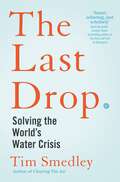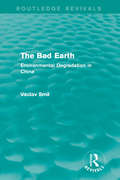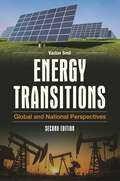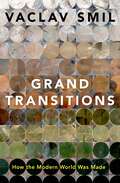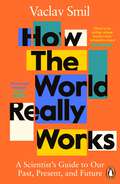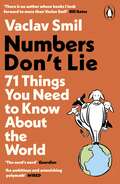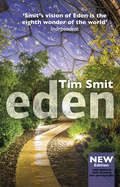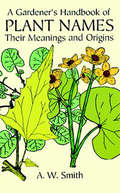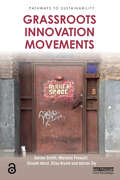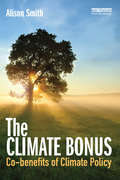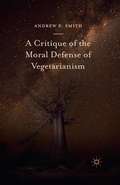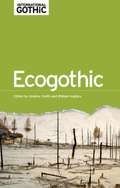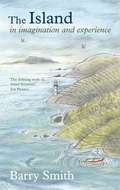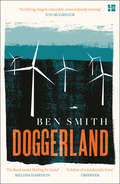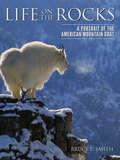- Table View
- List View
Sustaining the World's Wetlands: Setting Policy and Resolving Conflicts
by Richard SmardonWetlands throughout the world, including those described in this book are among the most sensitive and vulnerable ecosystems. They are critical habitats to the world’s migratory birds and a broad range of endangered mammal, reptile, amphibian, and plant species. They provide a broad range of flood storage, pollution control, water supply, ecotourism functions to indigenous peoples and country populations as a whole. They are also at the center of severe land and water use conflicts. These are conflicts between counties where wetland resources or the water supplies required for such resources involve more than one country. These are conflicts in use such as conflicts between habitat protection and charcoal production in mangroves. These are conflicts between groups of peoples such as indigenous peoples and hydropower advocates. Many wetlands have already been destroyed by water extractions, dams, levees, channelization, and fills. Others have been degraded by water pollution, overfishing and overhunting, timber harvest, and a host of other activities. This book describes these conflicts and international policies and institutions developed to protect and manage wetland resources. Most of the broader literature and other books on wetlands focuses on wildlife. Wildlife is described in the case studies, which follow. But, Richard Smardon provides us with more. He traces the history of conflicts and the development of policies and insti- tions to protect and manage wetland resources.
Revitalizing Urban Waterway Communities: Streams of Environmental Justice (Earthscan Studies in Water Resource Management)
by Richard Smardon Sharon Moran April Karen BaptisteThe revitalizing and restoration of rivers, creeks and streams is a major focus of urban conservation activity throughout North America and Europe. This book presents models and examples for organizing multiple stakeholders for purposes of waterway revitalization—if not restoration—within a context of fairness and environmental justice. After decades of neglect and misuse the challenge of cleaning up urban rivers and streams is shown to be complex and truly daunting. Urban river cleanup typically involves multiple agendas and stakeholders, as well as complicated technical issues. It is also often the situation that the most affected have the least voice in what happens. The authors present social process models for maximum inclusion of various stakeholders in decision-making for urban waterway regeneration. A range of examples is presented, drawn principally from North America and Europe.
Revitalizing Urban Waterway Communities: Streams of Environmental Justice (Earthscan Studies in Water Resource Management)
by Richard Smardon Sharon Moran April Karen BaptisteThe revitalizing and restoration of rivers, creeks and streams is a major focus of urban conservation activity throughout North America and Europe. This book presents models and examples for organizing multiple stakeholders for purposes of waterway revitalization—if not restoration—within a context of fairness and environmental justice. After decades of neglect and misuse the challenge of cleaning up urban rivers and streams is shown to be complex and truly daunting. Urban river cleanup typically involves multiple agendas and stakeholders, as well as complicated technical issues. It is also often the situation that the most affected have the least voice in what happens. The authors present social process models for maximum inclusion of various stakeholders in decision-making for urban waterway regeneration. A range of examples is presented, drawn principally from North America and Europe.
Clearing the Air: The Beginning and the End of Air Pollution
by Tim Smedley'Read this book and join the effort to terminate air pollution.' Arnold SchwarzeneggerAir pollution has become the world's greatest environmental health risk, and science is only beginning to reveal its wide-ranging effects. Globally, 19,000 people die each day from air pollution, killing more than HIV/AIDS, tuberculosis, malaria and car accidents combined.What happened to the air we breathe?Sustainability journalist Tim Smedley has travelled the world to try and find the answer, visiting cities at the forefront of the fight against air pollution, including Delhi, Beijing, London and Paris. With insights from the scientists and politicians leading the battle against it, and people whose lives have been affected by it,Clearing the Air tells the full story of air pollution for the first time: what it is, which pollutants are harmful, where they come from and – most importantly – what we can do about them.Air pollution is a problem that can be solved. The stories uncovered on this journey show us how.Clearing the Air is essential reading for anyone who cares about the air they breathe. And this much becomes clear: in the fight against air pollution, we all have a part to play. The fightback has begun.'Compulsory reading' Chris Boardman
The Last Drop: Solving the World's Water Crisis
by Tim SmedleyThe Times Book of the Year pick‘Smart, sobering, and scholarly. ’ – Steve Brusatte, the Sunday Times bestselling author of The Rise and Fall of DinosaursA gripping, thought-provoking and ultimately optimistic investigation into the world’s next great climate crisis – the scarcity of water.Water scarcity is the next big climate crisis. Water stress – not just scarcity, but also quality issues caused by pollution – is already driving the first waves of climate refugees. Rivers are drying out before they meet the oceans and ancient lakes are disappearing. It’s increasingly clear that human mismanagement of water is dangerously unsustainable, for both ecological and human survival. And yet in recent years some key countries have been quietly and very successfully addressing water stress.How are Singapore and Israel, for example – both severely water-stressed countries – not in the same predicament as Chennai or California?In The Last Drop, award-winning environmental journalist Tim Smedley meets experts, victims, activists and pioneers to find out how we can mend the water table that our survival depends upon. He offers a fascinating, universally relevant account of the environmental and human factors that have led us to this point, and suggests practical ways to address the crisis, before it’s too late.
The Bad Earth: Environmental Degradation in China (Routledge Revivals)
by Vaclav SmilAs China strives to significantly increase its economic output, the nation faces an acute deterioration of the physical resources from which this prodigious growth springs. Major problems include water shortages, the pollution of water, high levels of carcinogens in the air, accelerating erosion, and industrial pollution. Originally published in 1984, Vaclav Smil documents and evaluates China’s environmental crisis. This title will be of particular interest for students of Environmental Studies and Development Studies.
The Bad Earth: Environmental Degradation in China (Routledge Revivals)
by Vaclav SmilAs China strives to significantly increase its economic output, the nation faces an acute deterioration of the physical resources from which this prodigious growth springs. Major problems include water shortages, the pollution of water, high levels of carcinogens in the air, accelerating erosion, and industrial pollution. Originally published in 1984, Vaclav Smil documents and evaluates China’s environmental crisis. This title will be of particular interest for students of Environmental Studies and Development Studies.
Energy Transitions: Global and National Perspectives
by Vaclav SmilThis book provides a detailed, global examination of energy transitions, supplying a long-term historical perspective, an up-to-date assessment of recent and near-term advances in energy production technology and implementation, and an explanation of why efforts to limit global warming and to shift away from fossil fuels have been gradual.Based on the best international and national statistical sources, the second edition of Energy Transitions: Global and National Perspectives supplies an in-depth evaluation of how economies and nations around the world are striving to move away from traditional energy sources, the unfolding decarbonization process, and problems with intermittent energies and national transition plans. It supplies readers with a clear introduction to the basic properties of energy systems and key concepts of their appraisal, puts energy transition patterns in long-term historical perspective, and looks at the energy transition in eight of the world's leading economies. The last chapters focus on the advances in the decarbonization of the global energy supply and consider how the energy transition will continue in the coming decades.This fully updated and substantially expanded edition addresses the many new developments affecting energy supply, such as the recent expansion of hydraulic fracturing, oil price fluctuations, the Fukushima nuclear power plant catastrophe, advances in solar and wind generation, adoption of combined cycle gas turbines, and increased availability of electric cars. The coverage highlights the differences in the pace of transitions in various countries, thereby providing a complete and accurate picture of the current state of energy development in different parts of the world. The book serves as an invaluable resource for students as well as for anyone interested in a realistic appraisal of the current state of energy transitions in various nations and regions and the likely future development of the global energy supply.
Energy Transitions: Global and National Perspectives
by Vaclav SmilThis book provides a detailed, global examination of energy transitions, supplying a long-term historical perspective, an up-to-date assessment of recent and near-term advances in energy production technology and implementation, and an explanation of why efforts to limit global warming and to shift away from fossil fuels have been gradual.Based on the best international and national statistical sources, the second edition of Energy Transitions: Global and National Perspectives supplies an in-depth evaluation of how economies and nations around the world are striving to move away from traditional energy sources, the unfolding decarbonization process, and problems with intermittent energies and national transition plans. It supplies readers with a clear introduction to the basic properties of energy systems and key concepts of their appraisal, puts energy transition patterns in long-term historical perspective, and looks at the energy transition in eight of the world's leading economies. The last chapters focus on the advances in the decarbonization of the global energy supply and consider how the energy transition will continue in the coming decades.This fully updated and substantially expanded edition addresses the many new developments affecting energy supply, such as the recent expansion of hydraulic fracturing, oil price fluctuations, the Fukushima nuclear power plant catastrophe, advances in solar and wind generation, adoption of combined cycle gas turbines, and increased availability of electric cars. The coverage highlights the differences in the pace of transitions in various countries, thereby providing a complete and accurate picture of the current state of energy development in different parts of the world. The book serves as an invaluable resource for students as well as for anyone interested in a realistic appraisal of the current state of energy transitions in various nations and regions and the likely future development of the global energy supply.
Grand Transitions: How the Modern World Was Made
by Vaclav SmilWhat makes the modern world work? The answer to this deceptively simple question lies in four "grand transitions" of civilization--in populations, agriculture, energy, and economics--which have transformed the way we live. Societies that have undergone all four transitions emerge into an era of radically different population dynamics, food surpluses (and waste), abundant energy use, and expanding economic opportunities. Simultaneously, in other parts of the world, hundreds of millions remain largely untouched by these developments. Through erudite storytelling, Vaclav Smil investigates the fascinating and complex interactions of these transitions. He argues that the moral imperative to share modernity's benefits has become more acute with increasing economic inequality, but addressing this imbalance would make it exceedingly difficult to implement the changes necessary for the long-term preservation of the environment. Thus, managing the fifth transition--environmental changes from natural-resource depletion, biodiversity loss, and global warming--will determine the success or eventual failure of the grand transitions that have made the world we live in today.
Grand Transitions: How the Modern World Was Made
by Vaclav SmilWhat makes the modern world work? The answer to this deceptively simple question lies in four "grand transitions" of civilization--in populations, agriculture, energy, and economics--which have transformed the way we live. Societies that have undergone all four transitions emerge into an era of radically different population dynamics, food surpluses (and waste), abundant energy use, and expanding economic opportunities. Simultaneously, in other parts of the world, hundreds of millions remain largely untouched by these developments. Through erudite storytelling, Vaclav Smil investigates the fascinating and complex interactions of these transitions. He argues that the moral imperative to share modernity's benefits has become more acute with increasing economic inequality, but addressing this imbalance would make it exceedingly difficult to implement the changes necessary for the long-term preservation of the environment. Thus, managing the fifth transition--environmental changes from natural-resource depletion, biodiversity loss, and global warming--will determine the success or eventual failure of the grand transitions that have made the world we live in today.
How the World Really Works: A Scientist’s Guide to Our Past, Present and Future
by Vaclav Smil* THE NEW YORK TIMES BESTSELLER * 'Another masterpiece from one of my favorite authors . . . If you want a brief but thorough education in numeric thinking about many of the fundamental forces that shape human life, this is the book to read. It's a tour de force' BILL GATES __________ We have never had so much information at our fingertips and yet most of us don't know how the world really works. This book explains seven of the most fundamental realities governing our survival and prosperity. From energy and food production, through our material world and its globalization, to risks, our environment and its future, How the World Really Works offers a much-needed reality check - because before we can tackle problems effectively, we must understand the facts. In this ambitious and thought-provoking book we see, for example, that globalization isn't inevitable and that our societies have been steadily increasing their dependence on fossil fuels, making their complete and rapid elimination unlikely. Drawing on the latest science and tackling sources of misinformation head on - from Yuval Noah Harari to Noam Chomsky - ultimately Smil answers the most profound question of our age: are we irrevocably doomed or is a brighter utopia ahead? __________ 'Very informative and eye-opening in many ways' HA-JOON CHANG, author of 23 Things They Don't Tell You About Capitalism 'If you are anxious about the future, and infuriated that we aren't doing enough about it, please read this book' PAUL COLLIER, author of The Future of Capitalism
Numbers Don't Lie: 71 Things You Need to Know About the World
by Vaclav Smil'There is no author whose books I look forward to more than Vaclav Smil' Bill GatesIs flying dangerous? How much do the world's cows weigh? And what makes people happy?From earth's nations and inhabitants, through the fuels and foods that energize them, to the transportation and inventions of our modern world - and how all of this affects the planet itself - in Numbers Don't Lie, Professor Vaclav Smil takes us on a fact-finding adventure, using surprising statistics and illuminating graphs to challenge lazy thinking.Packed with 'Well-I-never-knew-that' information and with fascinating and unusual examples throughout, we find out how many people it took to build the Great Pyramid, that vaccination yields the best return on investment, and why electric cars aren't as great as we think (yet). There's a wonderful mix of science, history and wit, all in bite-sized chapters on a broad range of topics.Urgent and essential, Numbers Don't Lie inspires readers to interrogate what they take to be true in these significant times. Smil is on a mission to make facts matter, because after all, numbers may not lie, but which truth do they convey?'He is rigorously numeric, using data to illuminate every topic he writes about. The word "polymath" was invented to describe people like him' Bill Gates 'Important' Mark Zuckerberg, on Energy 'One of the world's foremost thinkers on development history and a master of statistical analysis . . . The nerd's nerd' Guardian 'There is perhaps no other academic who paints pictures with numbers like Smil' Guardian 'In a world of specialized intellectuals, Smil is an ambitious and astonishing polymath who swings for fences . . . They're among the most data-heavy books you'll find, with a remarkable way of framing basic facts' Wired 'Vaclav Smil has led a 30-year career of interdisciplinary contrarianism, writing hundreds of scientific articles and dozens of books attacking sacred cows of Western environmental and geopolitical thought' Foreign Policy 'For a couple of decades, Vaclav Smil has been on my go-to list when questions arise about global trends and risks, and particularly about energy. He is a distinguished professor on the environment faculty at the University of Manitoba but really should be in the department of everything' Andrew Revkin, The New York Times 'One of the world's foremost experts on energy' Foreign Affairs 'An author who does not allow facts to be obscured or overshadowed by politics' New York Review of Books 'The man who has quietly shaped how the world thinks about energy' Science Magazine 'A radical thinker on energy and environmental issues' Financial Times 'He's a slayer of bullshit' David Keith, Gordon McKay Professor of Applied Physics & Professor of Public Policy, Harvard UniversityVaclav Smil is Distinguished Professor Emeritus at the University of Manitoba. He is the author of over forty books on topics including energy, environmental and population change, food production and nutrition, technical innovation, risk assessment and public policy. No other living scientist has had more books (on a wide variety of topics) reviewed in Nature. A Fellow of the Royal Society of Canada, in 2010 he was named by Foreign Policy as one of the Top 100 Global Thinkers. This is his first book for a more general readership.
Eden: Updated 15th Anniversary Edition
by Tim SmitUpdated, with stunning new photographs At the beginning of the twenty-first century, the impossible was delivered. From the sterile depths of a disused china clay pit in Cornwall rose one of the most remarkable and ambitious ventures in recent memory. The Eden Project’s Biomes, the world’s largest conservatories, are the symbol of a living theatre of plants and people and their interdependence, of regeneration and of a pioneering forum for the exploration of possible futures. This is the extraordinary story of the Eden Project, of its conception, design and construction, of the larger-than-life personalities who made it happen and of all that has happened since its doors were first opened to the public in 2001. It is now undisputedly one of the world’s great gardens with more than 17 million visitors flocking there and projects and partnerships all over the world.
A Gardener's Handbook of Plant Names: Their Meanings and Origins
by A. W. SmithFirst compact dictionary to combine definitions of botanical names in general usage with information on their derivation and guides to pronunciation. A monumental index provides a cross-reference from some 1,800 common plant names to corresponding botanical ones. Combines thoroughness, botanical rigor, and interesting facts and lore — all leavened with touches of humor.
Grassroots Innovation Movements (Pathways to Sustainability)
by Adrian Smith Mariano Fressoli Dinesh Abrol Elisa Arond Adrian ElyInnovation is increasingly invoked by policy elites and business leaders as vital for tackling global challenges like sustainable development. Often overlooked, however, is the fact that networks of community groups, activists, and researchers have been innovating grassroots solutions for social justice and environmental sustainability for decades. Unencumbered by disciplinary boundaries, policy silos, or institutional logics, these ‘grassroots innovation movements’ identify issues and questions neglected by formal science, technology and innovation organizations. Grassroots solutions arise in unconventional settings through unusual combinations of people, ideas and tools. This book examines six diverse grassroots innovation movements in India, South America and Europe, situating them in their particular dynamic historical contexts. Analysis explains why each movement frames innovation and development differently, resulting in a variety of strategies. The book explores the spaces where each of these movements have grown, or attempted to do so. It critically examines the pathways they have developed for grassroots innovation and the challenges and limitations confronting their approaches. With mounting pressure for social justice in an increasingly unequal world, policy makers are exploring how to foster more inclusive innovation. In this context grassroots experiences take on added significance. This book provides timely and relevant ideas, analysis and recommendations for activists, policy-makers, students and scholars interested in encounters between innovation, development and social movements.
Grassroots Innovation Movements (Pathways to Sustainability)
by Adrian Smith Mariano Fressoli Dinesh Abrol Elisa Arond Adrian ElyInnovation is increasingly invoked by policy elites and business leaders as vital for tackling global challenges like sustainable development. Often overlooked, however, is the fact that networks of community groups, activists, and researchers have been innovating grassroots solutions for social justice and environmental sustainability for decades. Unencumbered by disciplinary boundaries, policy silos, or institutional logics, these ‘grassroots innovation movements’ identify issues and questions neglected by formal science, technology and innovation organizations. Grassroots solutions arise in unconventional settings through unusual combinations of people, ideas and tools. This book examines six diverse grassroots innovation movements in India, South America and Europe, situating them in their particular dynamic historical contexts. Analysis explains why each movement frames innovation and development differently, resulting in a variety of strategies. The book explores the spaces where each of these movements have grown, or attempted to do so. It critically examines the pathways they have developed for grassroots innovation and the challenges and limitations confronting their approaches. With mounting pressure for social justice in an increasingly unequal world, policy makers are exploring how to foster more inclusive innovation. In this context grassroots experiences take on added significance. This book provides timely and relevant ideas, analysis and recommendations for activists, policy-makers, students and scholars interested in encounters between innovation, development and social movements.
The Climate Bonus: Co-benefits of Climate Policy
by Alison SmithWe urgently need to transform to a low carbon society, yet our progress is painfully slow, in part because there is widespread public concern that this will require sacrifice and high costs. But this need not be the case. Many carbon reduction policies provide a range of additional benefits, from reduced air pollution and increased energy security to financial savings and healthier lifestyles, that can offset the costs of climate action. This book maps out the links between low carbon policies and their co-benefits, and shows how low carbon policies can lead to cleaner air and water, conservation of forests, more sustainable agriculture, less waste, safer and more secure energy, cost savings for households and businesses and a stronger and more stable economy. The book discusses the ways in which joined-up policies can help to maximise the synergies and minimise the conflicts between climate policy and other aspects of sustainability. Through rigorous analysis of the facts, the author presents well-reasoned and evidenced recommendations for policy-makers and all those with an interest in making a healthier and happier society. This book shows us how, instead of being paralysed by the threat of climate change, we can use it as a stimulus to escape from our dependence on polluting fossil fuels, and make the transition to a cleaner, safer and more sustainable future.
The Climate Bonus: Co-benefits of Climate Policy
by Alison SmithWe urgently need to transform to a low carbon society, yet our progress is painfully slow, in part because there is widespread public concern that this will require sacrifice and high costs. But this need not be the case. Many carbon reduction policies provide a range of additional benefits, from reduced air pollution and increased energy security to financial savings and healthier lifestyles, that can offset the costs of climate action. This book maps out the links between low carbon policies and their co-benefits, and shows how low carbon policies can lead to cleaner air and water, conservation of forests, more sustainable agriculture, less waste, safer and more secure energy, cost savings for households and businesses and a stronger and more stable economy. The book discusses the ways in which joined-up policies can help to maximise the synergies and minimise the conflicts between climate policy and other aspects of sustainability. Through rigorous analysis of the facts, the author presents well-reasoned and evidenced recommendations for policy-makers and all those with an interest in making a healthier and happier society. This book shows us how, instead of being paralysed by the threat of climate change, we can use it as a stimulus to escape from our dependence on polluting fossil fuels, and make the transition to a cleaner, safer and more sustainable future.
A Critique of the Moral Defense of Vegetarianism
by Andrew F. SmithDrawing on research in plant science, systems ecology, environmental philosophy, and cultural anthropology, Andrew F. Smith shatters the distinction between vegetarianism and omnivorism. The book outlines the implications that these manufactured distinctions have for how we view food and ourselves as eaters.
EcoGothic (International Gothic Series)
by Andrew Smith William HughesThis book will provide the first study of how the Gothic engages with ecocritical ideas. Ecocriticism has frequently explored images of environmental catastrophe, the wilderness, the idea of home, constructions of 'nature', and images of the post-apocalypse – images which are also central to a certain type of Gothic literature. By exploring the relationship between the ecocritical aspects of the Gothic and the Gothic elements of the ecocritical, this book provides a new way of looking at both the Gothic and ecocriticism. Writers discussed include Ann Radcliffe, Mary Shelley, Ambrose Bierce, Algernon Blackwood, Margaret Atwood, Cormac McCarthy, Dan Simmons and Rana Dasgupta. The volume thus explores writing and film across various national contexts including Britain, America and Canada, as well as giving due consideration to how such issues might be discussed within a global context.
EcoGothic (International Gothic Series)
by Andrew Smith William HughesThis book will provide the first study of how the Gothic engages with ecocritical ideas. Ecocriticism has frequently explored images of environmental catastrophe, the wilderness, the idea of home, constructions of 'nature', and images of the post-apocalypse – images which are also central to a certain type of Gothic literature. By exploring the relationship between the ecocritical aspects of the Gothic and the Gothic elements of the ecocritical, this book provides a new way of looking at both the Gothic and ecocriticism. Writers discussed include Ann Radcliffe, Mary Shelley, Ambrose Bierce, Algernon Blackwood, Margaret Atwood, Cormac McCarthy, Dan Simmons and Rana Dasgupta. The volume thus explores writing and film across various national contexts including Britain, America and Canada, as well as giving due consideration to how such issues might be discussed within a global context.
The Island in Imagination and Experience: Antarctica And Subantarctic Islands 1959-2006
by Barry SmithFrom Treasure Island to Robben Island, from the paradise of Thomas More's 'Utopia' to Napoleon's purgatory on Elba, islands have proved irresistible to mankind's imagination since time immemorial. Self-confessed islomaniac Barry Smith explores how islands bewitch us so, and examines the kind of human experiences that islands inspire. Journeying all around the globe to take in the most fascinating stories of Earth's half a million islands, this book considers the unique geography, politics and economics of islands and their cultures. It traces their singular place in literature, religion and philosophy, and disentangles the myths and the facts to reveal just why islands exert such an insistent grip on the human psyche. 'Fascinating and wide-ranging.' Island Review 'A fascinating survey of the interplay between those little dots of land and the human imagination… Smith is excellent on the ways in which islands have always been pawns in geopolitical games…witty.' Geographical "Magisterial… A harrowing, enthralling piece of work that bears comparison with John Prebble's equally dense, equally passionate classic, The Highland Clearances … [A] fascinating, scrupulous, angry, scholarly book." Jim Perrin, The Great Outdoors
Doggerland
by Ben Smith‘The Road meets Waiting for Godot: powerful, unforgettable, unique’ Melissa Harrison, author of At Hawthorn Time. Doggerland is a superbly gripping debut novel about loneliness and hope, nature and survival – set on an off-shore windfarm in the not-so-distant future.
Life on the Rocks: A Portrait of the American Mountain Goat
by Bruce L. SmithThe American mountain goat is one of the most elusive and least familiar species of hoofed mammals in North America. Confined to the remote and rugged mountains of the western United States and Canada, these extraordinary mountaineers are seldom seen or encountered, even by those who patiently study them. Life on the Rocks offers an intimate portrayal of this remarkable animal through the eyes and lens of field biologist and photographer Bruce Smith. Color photographs and accounts of Smith's personal experiences living in Montana's Selway-Bitterroot Wilderness Area accompany descriptions of the American mountain goat's natural history. Smith explores their treacherous habitat, which spans the perilous cliffs and crags of the Rocky, Cascade, and Coast mountain ranges. The physical and behavioral adaptations of these alpine athletes enable them to survive a host of dangers, including six-month-long winters, scarce food sources, thunderous avalanches, social strife, and predators like wolves, bears, lions, wolverines, and eagles. Smith also details the challenges these animals face as their territory is threatened by expanding motorized access, industrial activities, and a warming climate. Life on the Rocks showcases the elegance and charm of this little-known creature, thriving in some of North America's harshest wilderness. Smith's volume will appeal to wildlife enthusiasts, wildland travelers, and conservationists interested in the future of the American mountain goat. 2014 National Outdoor Book Award winner: Nature & Environment and co-winner: Design and Artistic Merit



